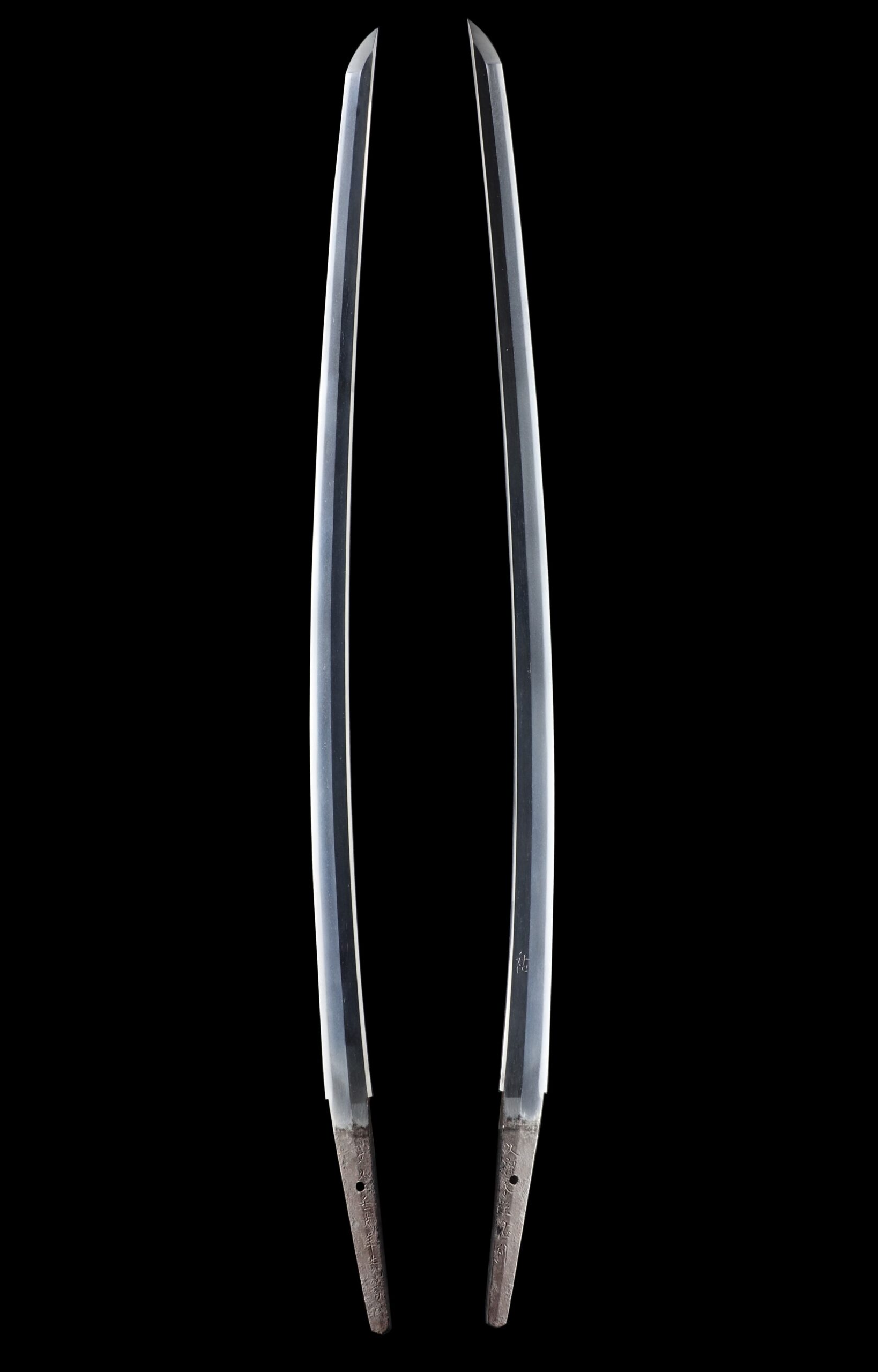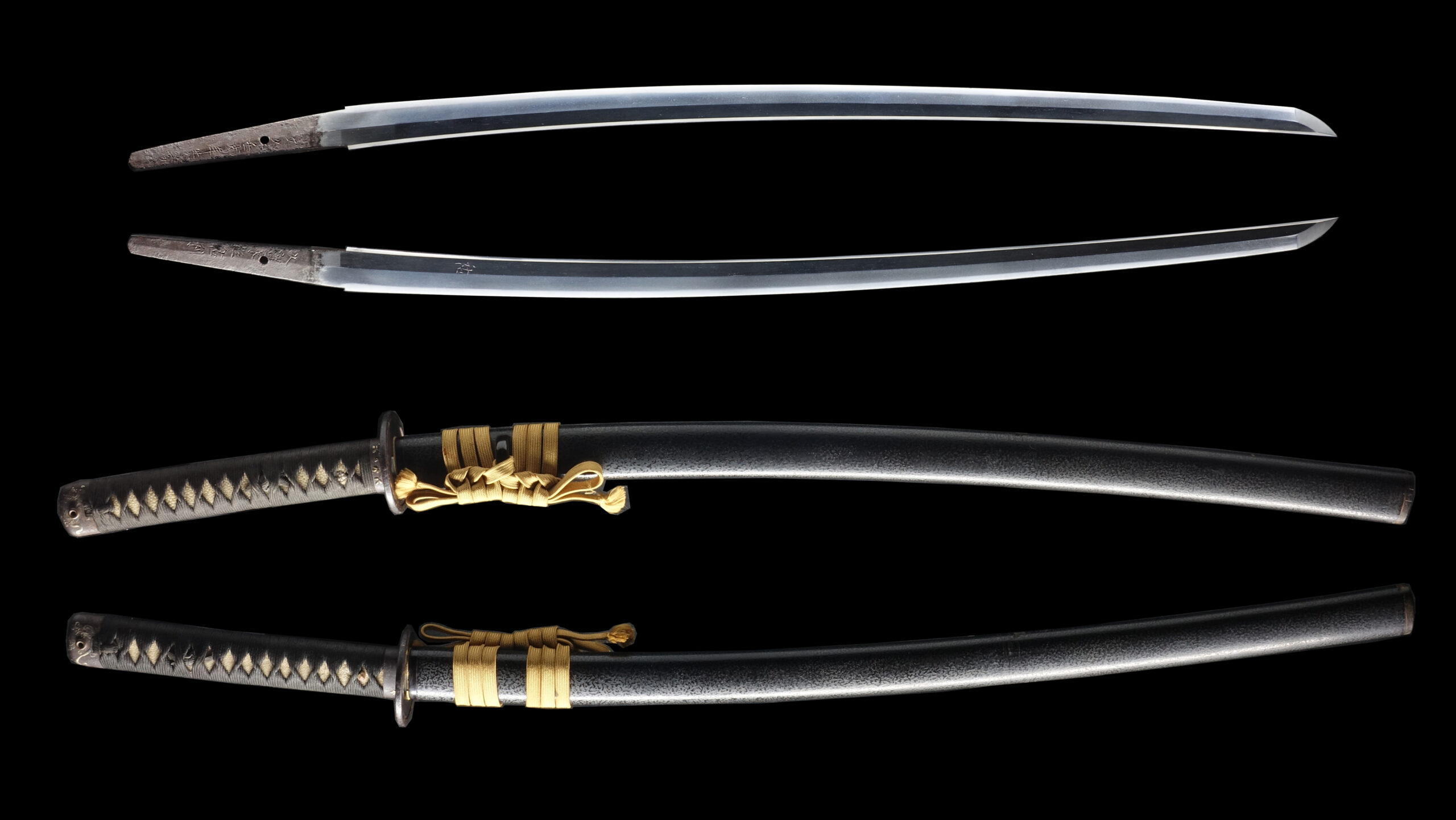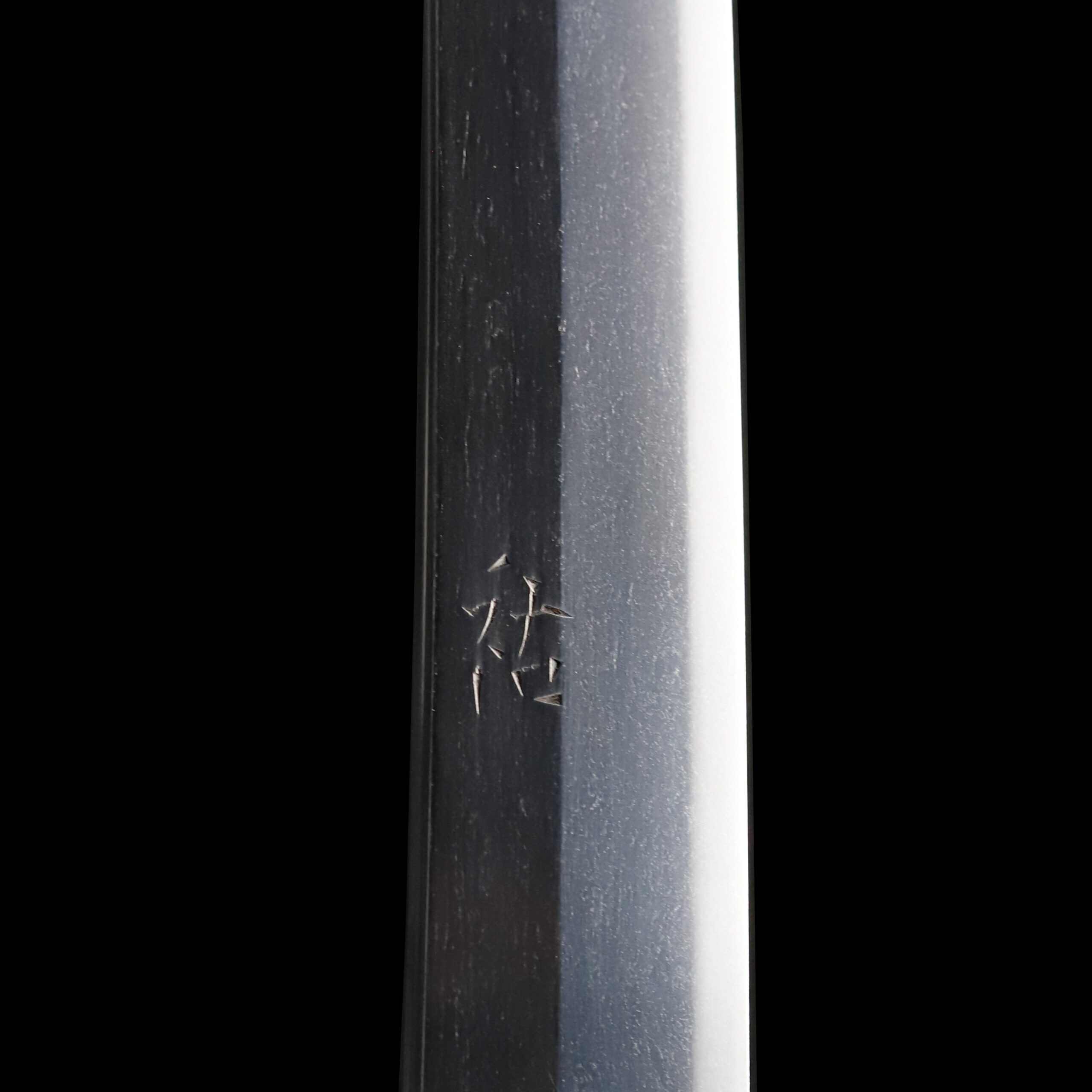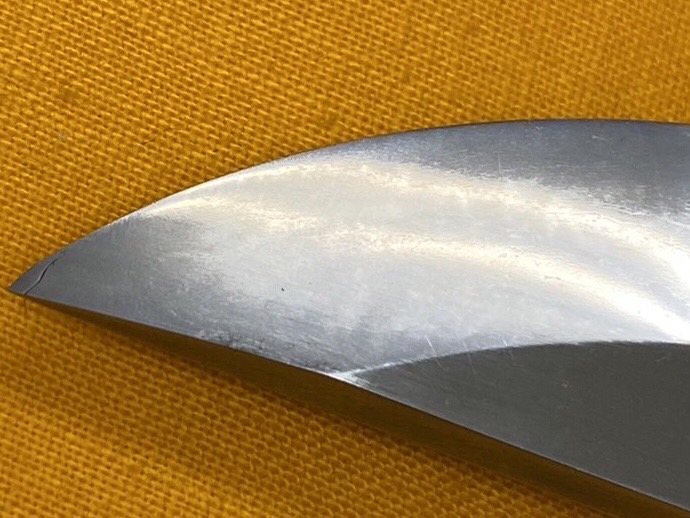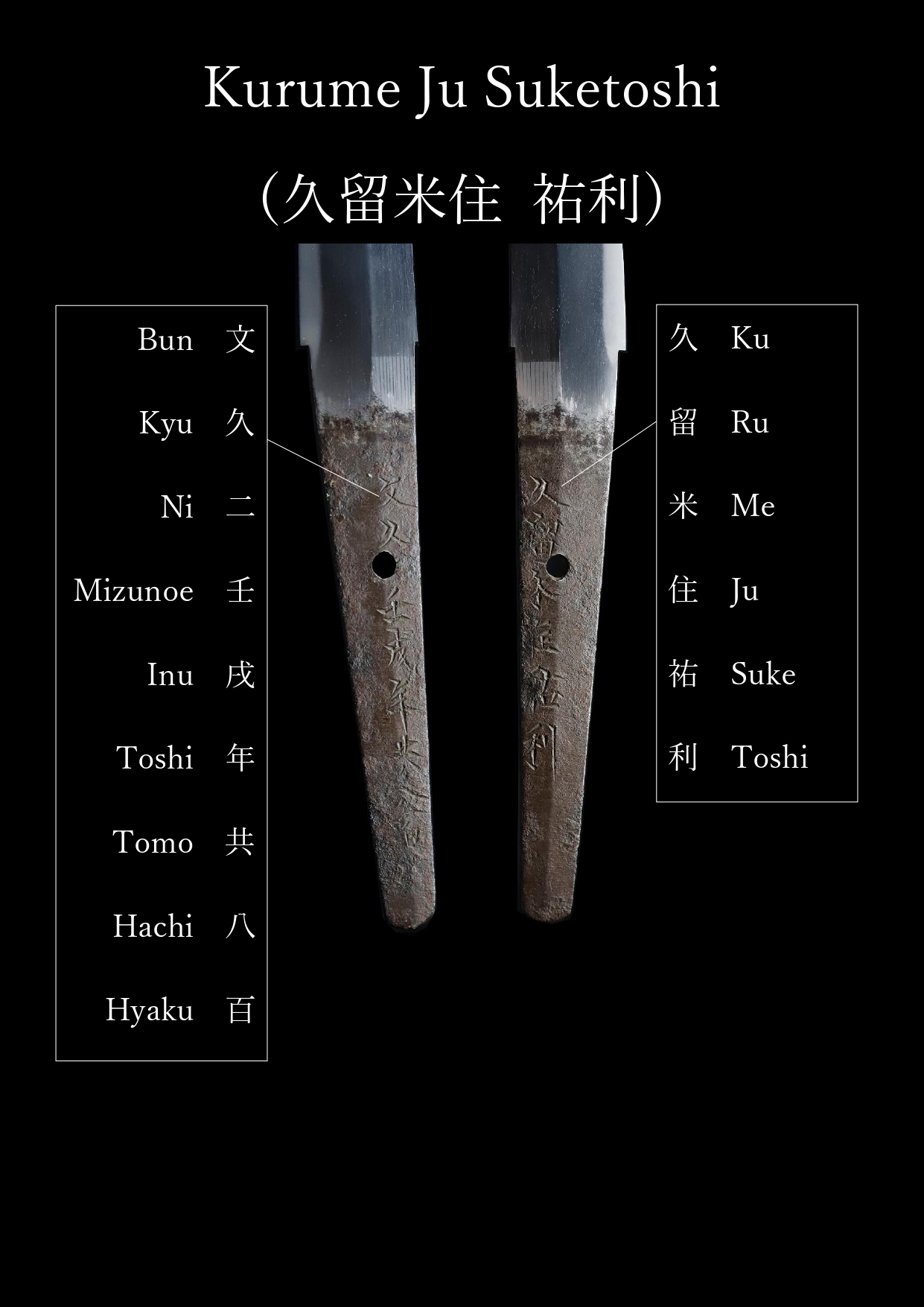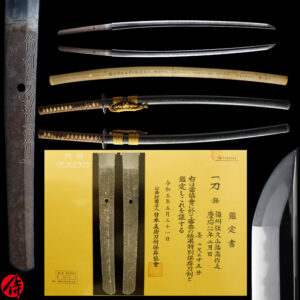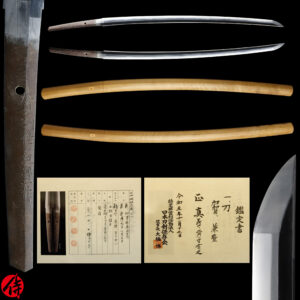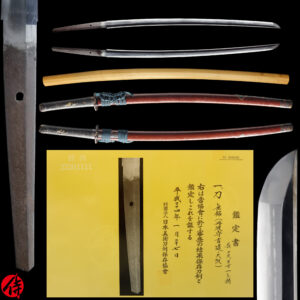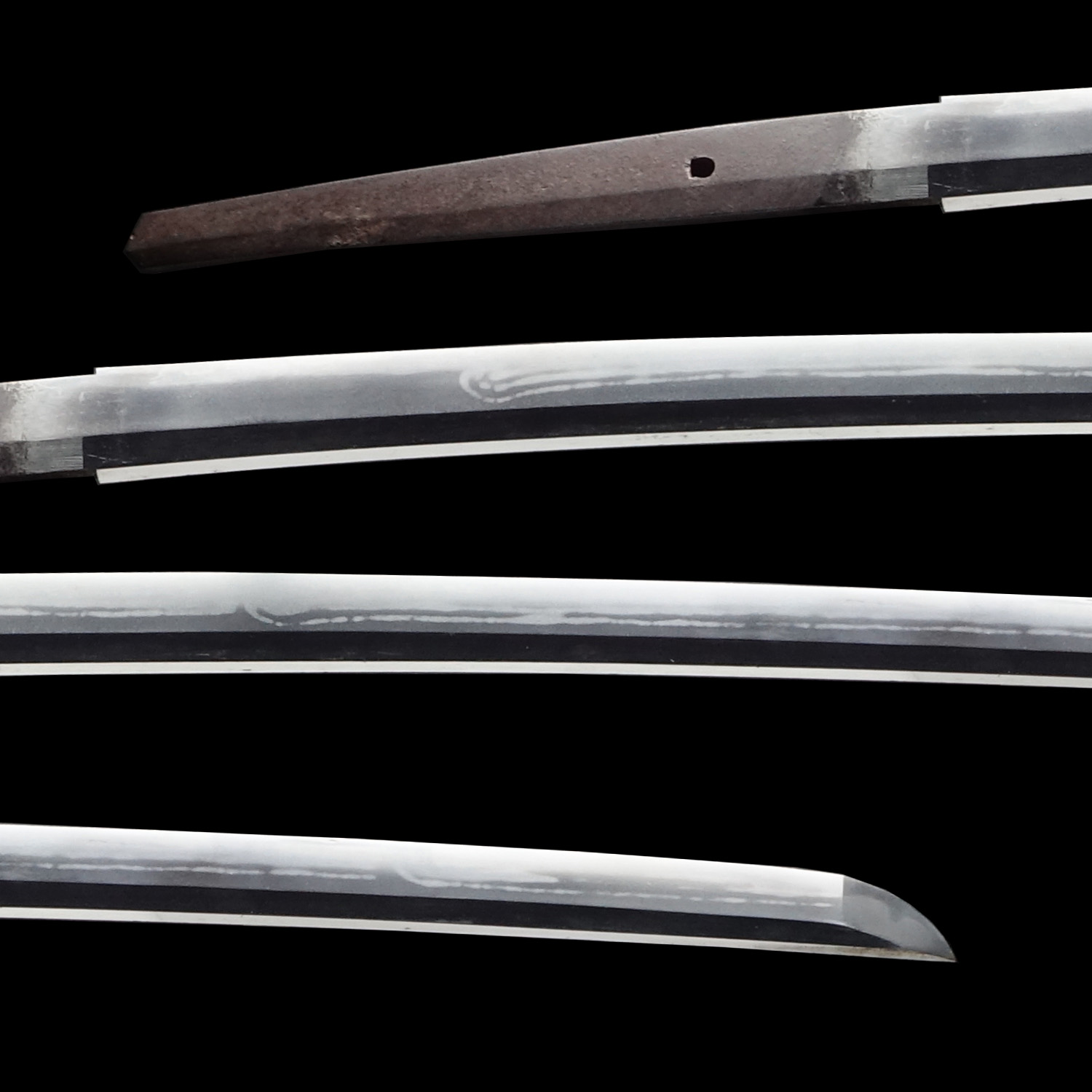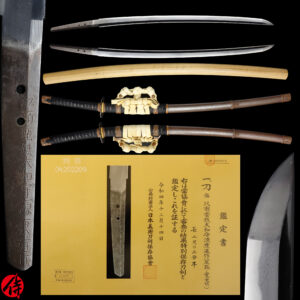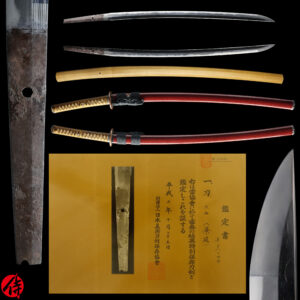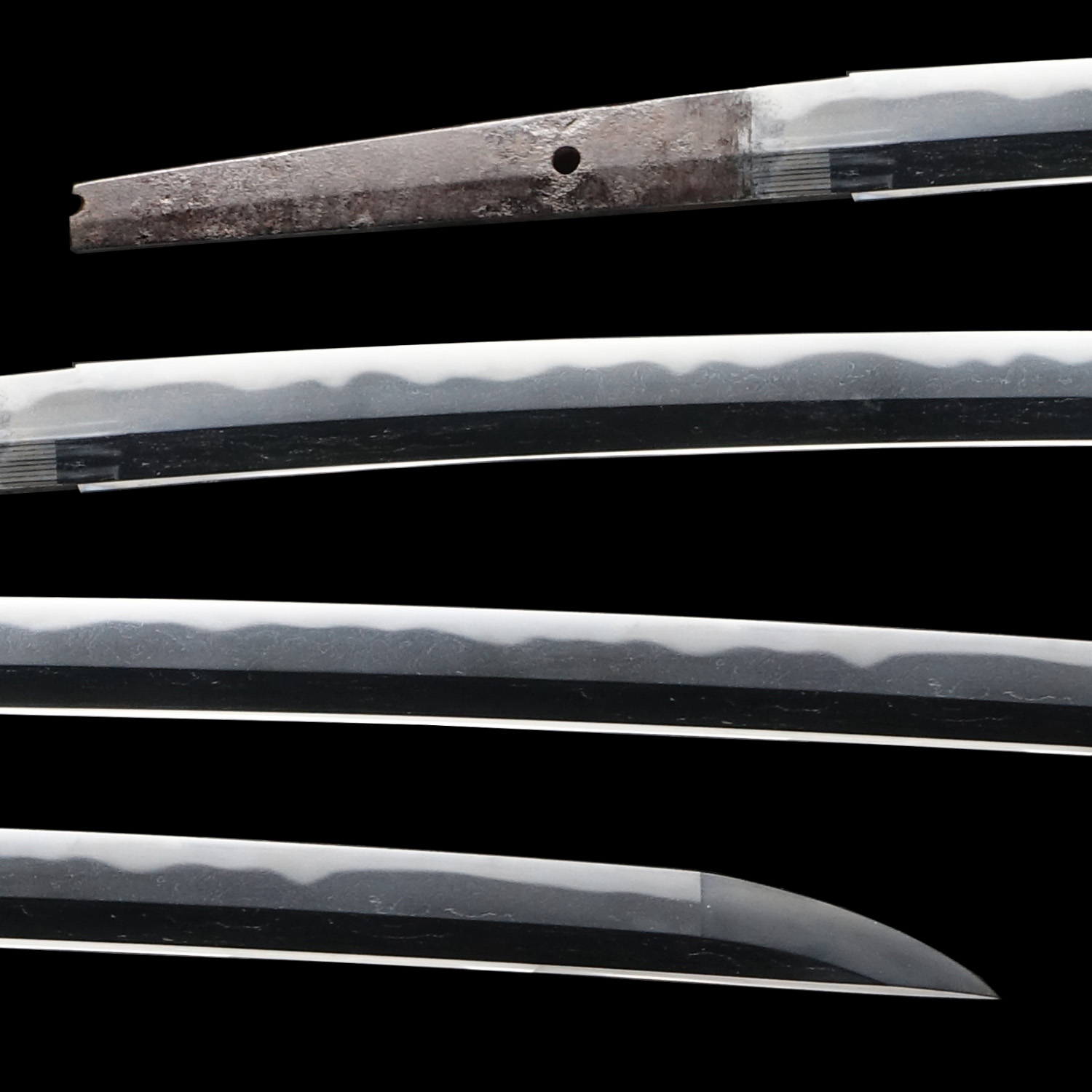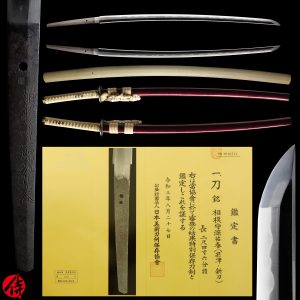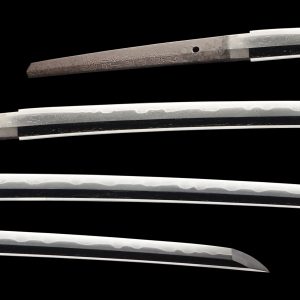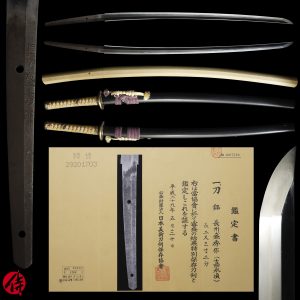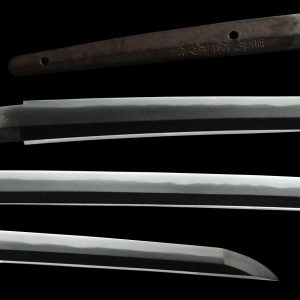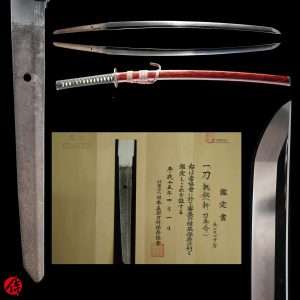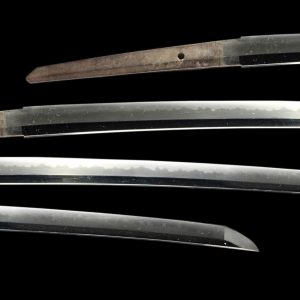Antique Japanese Sword Katana Signed by Suketoshi with Hozon Certificate
【Description】
Summary
This blade was signed by Kurume Jyu Suketoshi (久留米住祐利) in the second year of the Bunkyu era (1862: The end of the Edo period). Kurume is the name of the town located in today’s Fukuoka prefecture. Kurume Jyu means that he resided in this area when he forged this blade. He was an apprentice of Kaga no Suke Sukenaga, who was one of the most prominent figures in Bizen Osafune school in Okayama prefecture. Suketoshi learned highly refined sword-forging techniques from his master and eventually moved to Kurume town. Suketoshi was a Hanko for Kurume domain, meaning he exclusively forged blades for this domain. He was active during the end of the Edo period- the begining of the Meiji era. Since this blade was registered in Fukuoka prefecture, it is likely that its previous owner is descendant of a Samurai who lived in Chikuzen province.
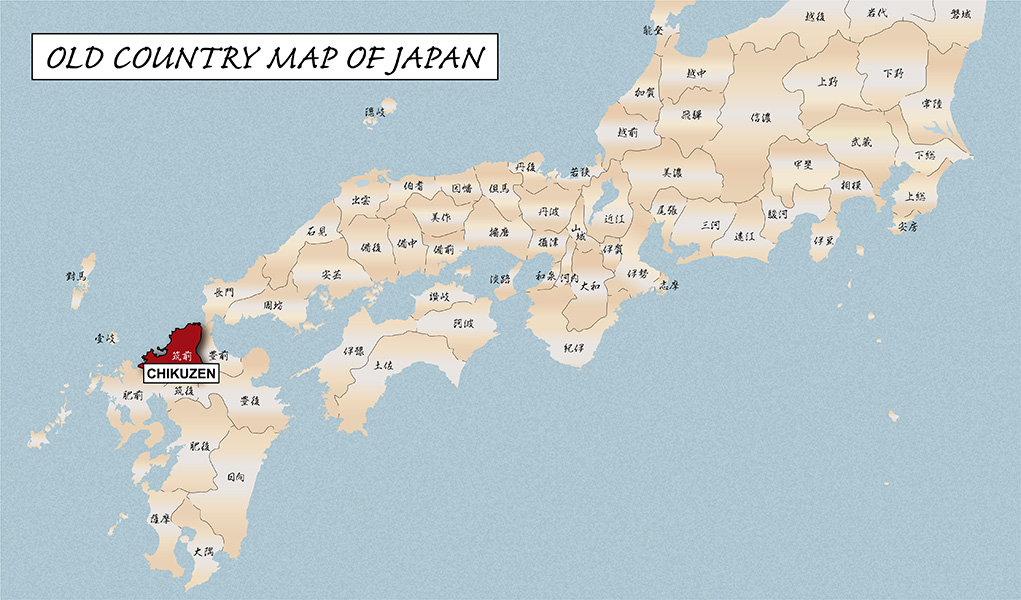
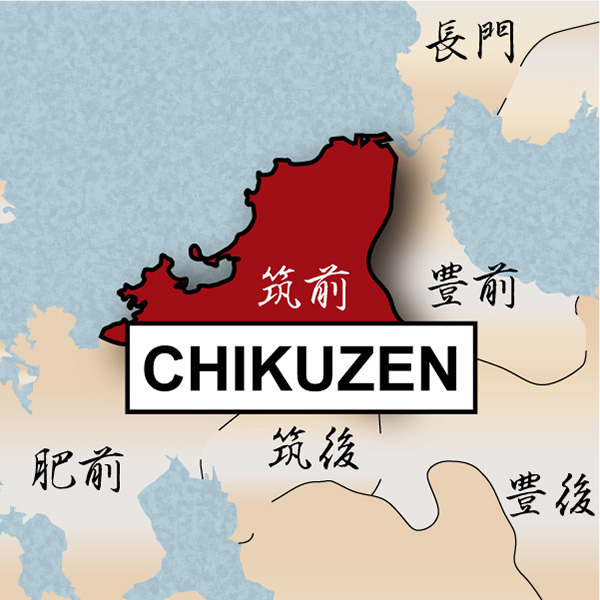
About Sukenaga(His master)
Bizen Osafune Jyu Sukenaga(備前長船住祐永) is one of the most famous swordsmiths in Bizen province at the end of the Edo period(Bakumatsu). Born as the second son of Yokoyama Sukehira, he belonged to the Yokoyama school in Bizen province(today’s Okayama prefecture).
He eventually became the head of this school. He called himself the 56th-gen of Tomonari, a renowned swordsmith in the mid-late Heian period in Bizen province. He was allowed to inscribe a chrysanthemum emblem, which is the symbol of the Japanese emperor. His sword forging technique was so great that the emperor allowed him to use this emblem, which was quite honorable for any swordsmith. He trained many apprentices such as Suketoshi.
Background
Japan enjoyed a relatively peaceful time from the early Edo period to the mid-Edo period(the 1600s-1760s) because of the stable economy and the powerful government run by Tokugawa Shogun. Samurai didn’t have many opportunities to utilize his Katana sword in public or on battlefields during this time. Thus, they carried their swords more as a symbol of their social status. The demand for weapons decreased accordingly compared to the previous Warring state period called Sengoku Jidai (1467-1600).
However, toward the end of the Edo period(1764-1876), the Japanese sword’s role changed dramatically. With the poverty spreading in Japan, there were so many riots initiated by the civilians. Japanese sword started to play an essential role in maintaining public safety.
Pressure from foreign countries to open Japanese borders also forced Samurai to order strong-looking swords to survive this tumultuous time. We believe many swordsmiths, including Suketoshi, made great efforts to forged high-quality, practical blades for their masters to prepare for battles.
There was a civil war between Tokugawa’s military government and the new Meiji government at the end of the Edo period. That means the original owner of this Katana might have seen the moment when Samurai’s life changed forever.
It is appraised as a Hozon Touken (保存刀剣) issued by NBTHK (Nihon Bijutsu Touken Hozon Kyokai:日本美術刀剣保存協会). This authentication paper was only given to authentic Japanese swords, especially well preserved and high quality with artistic value.
*Please keep in mind that there is a visible Kizu near the tip of this blade. If you like to know the detailed condition, please feel free to contact us.
【 Blade】
Cutting Edge Length (Nagasa): 66.7 cm (26.2 inches)
Curvature (Sori): 1.6 cm (0.63 inches)

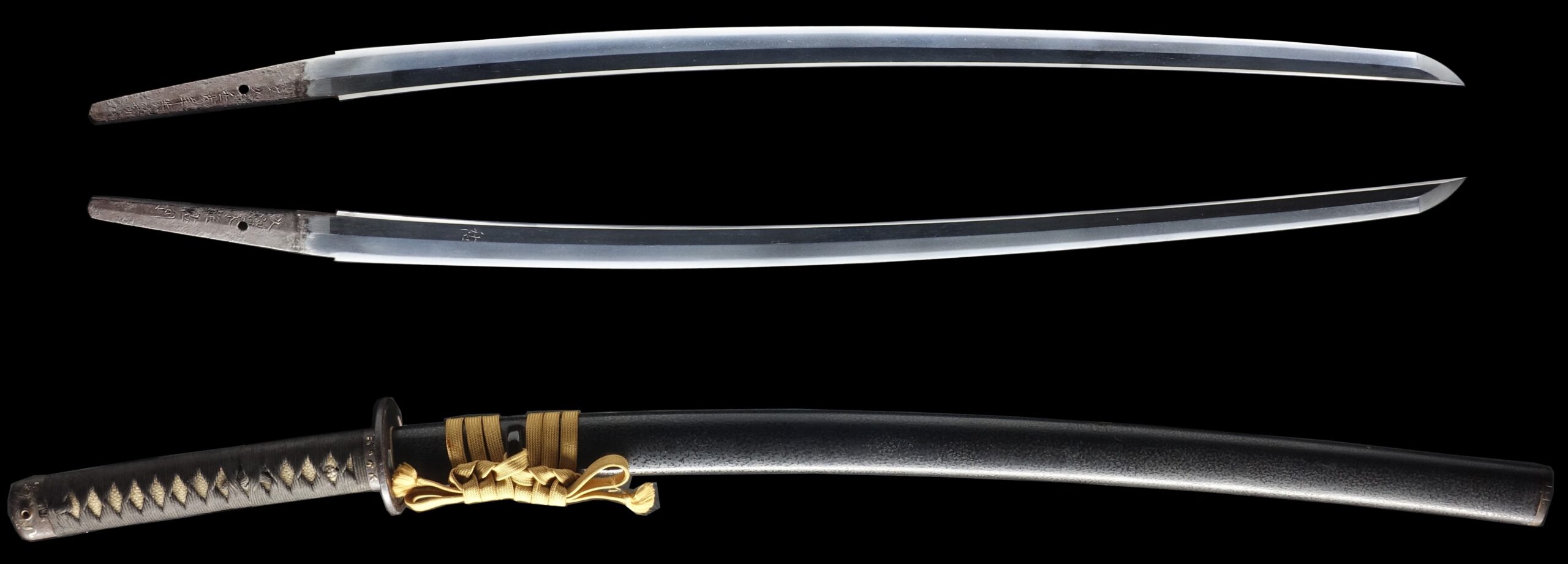
Hamon:
the crystalline structure which forms along the cutting edge of a blade as a result of the hardening process
Jimon (Jihada):
visible steel surface pattern created by folding and hammering during forging process
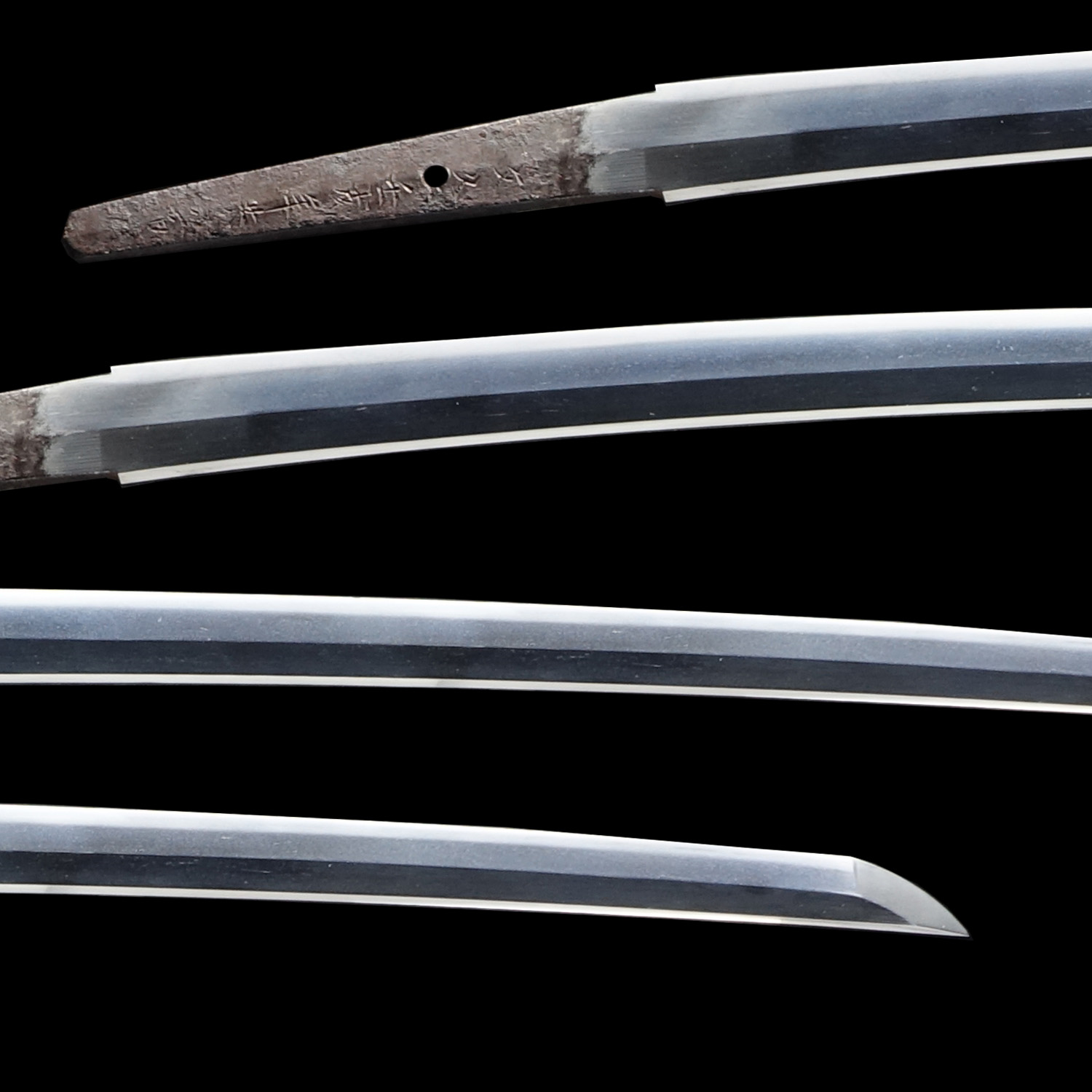
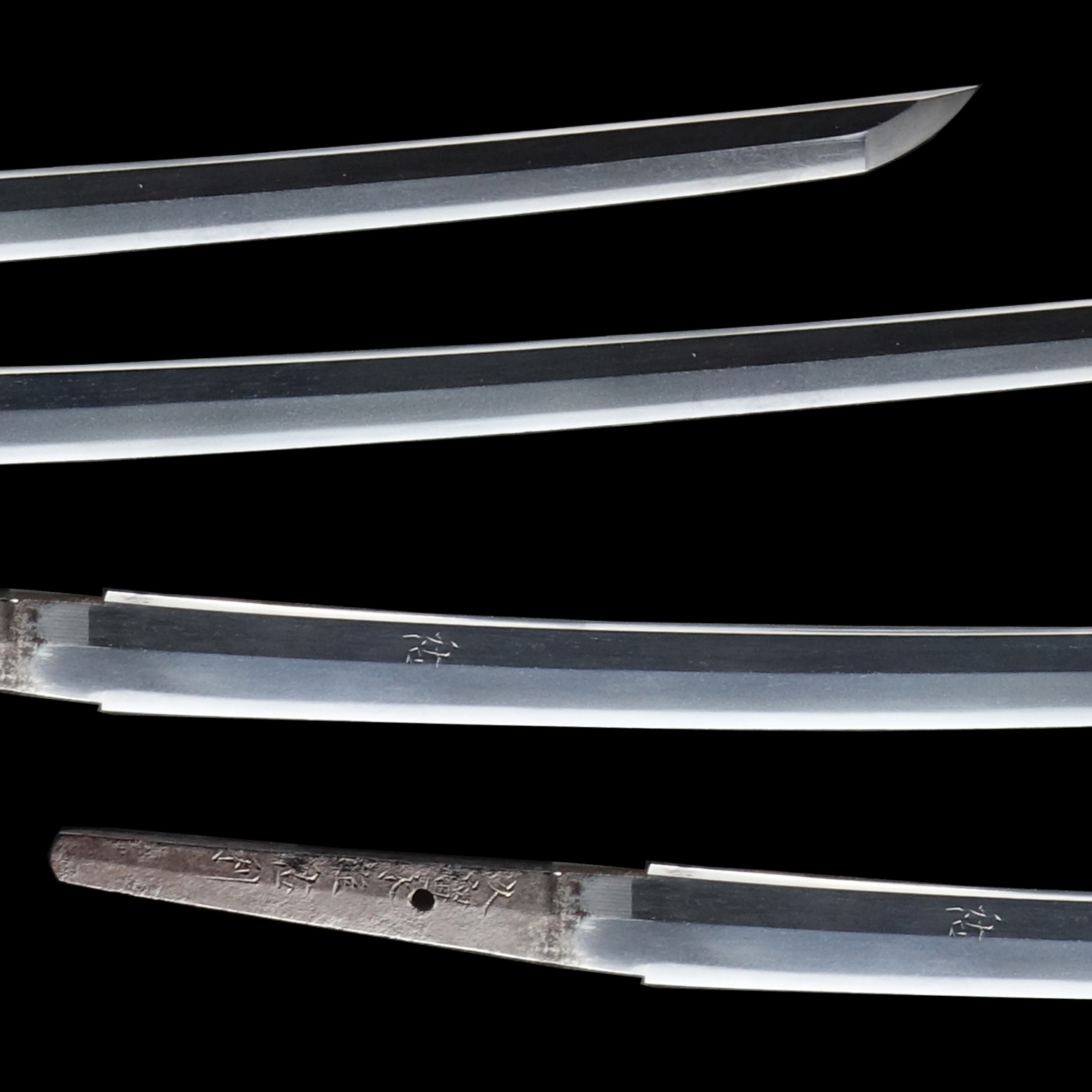
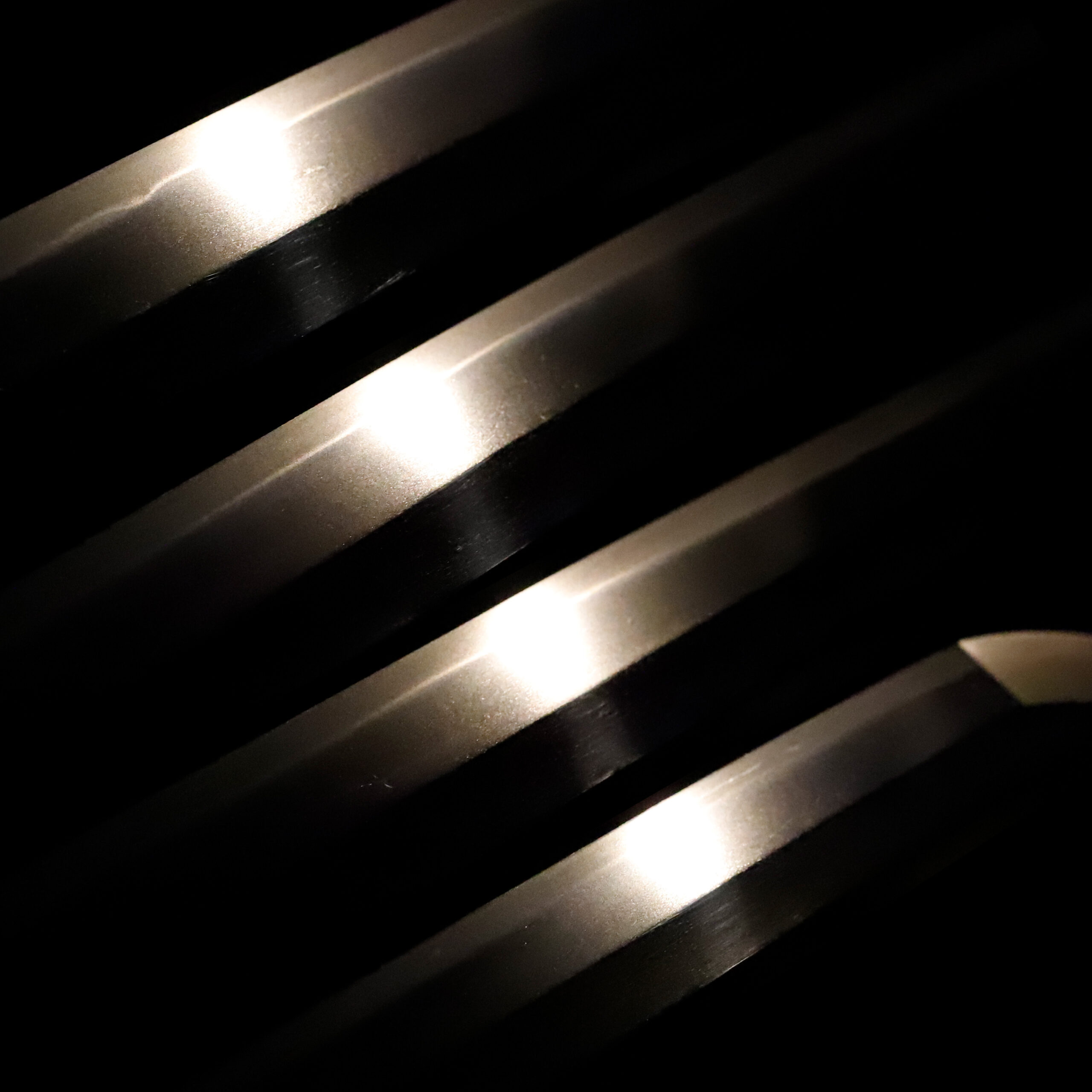
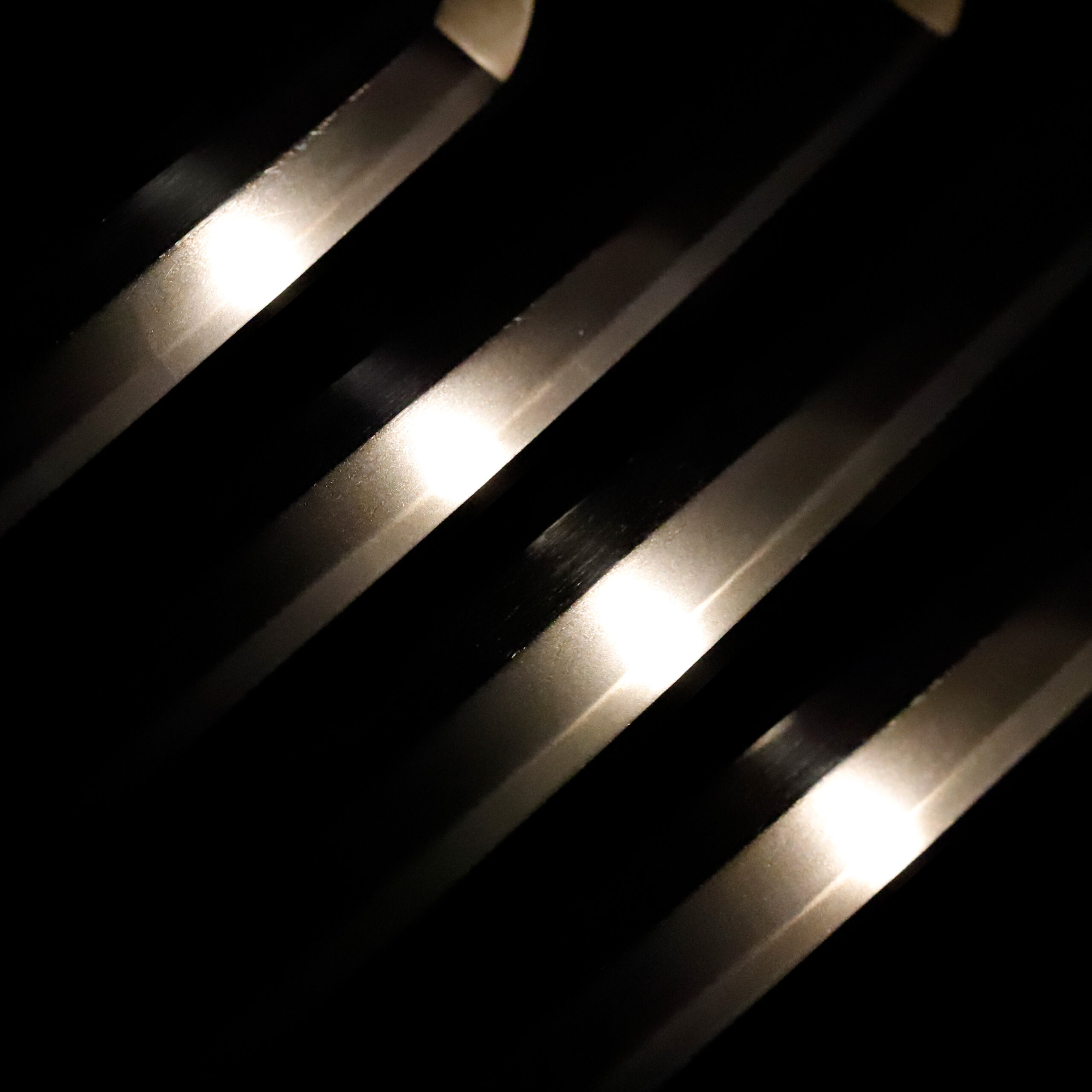
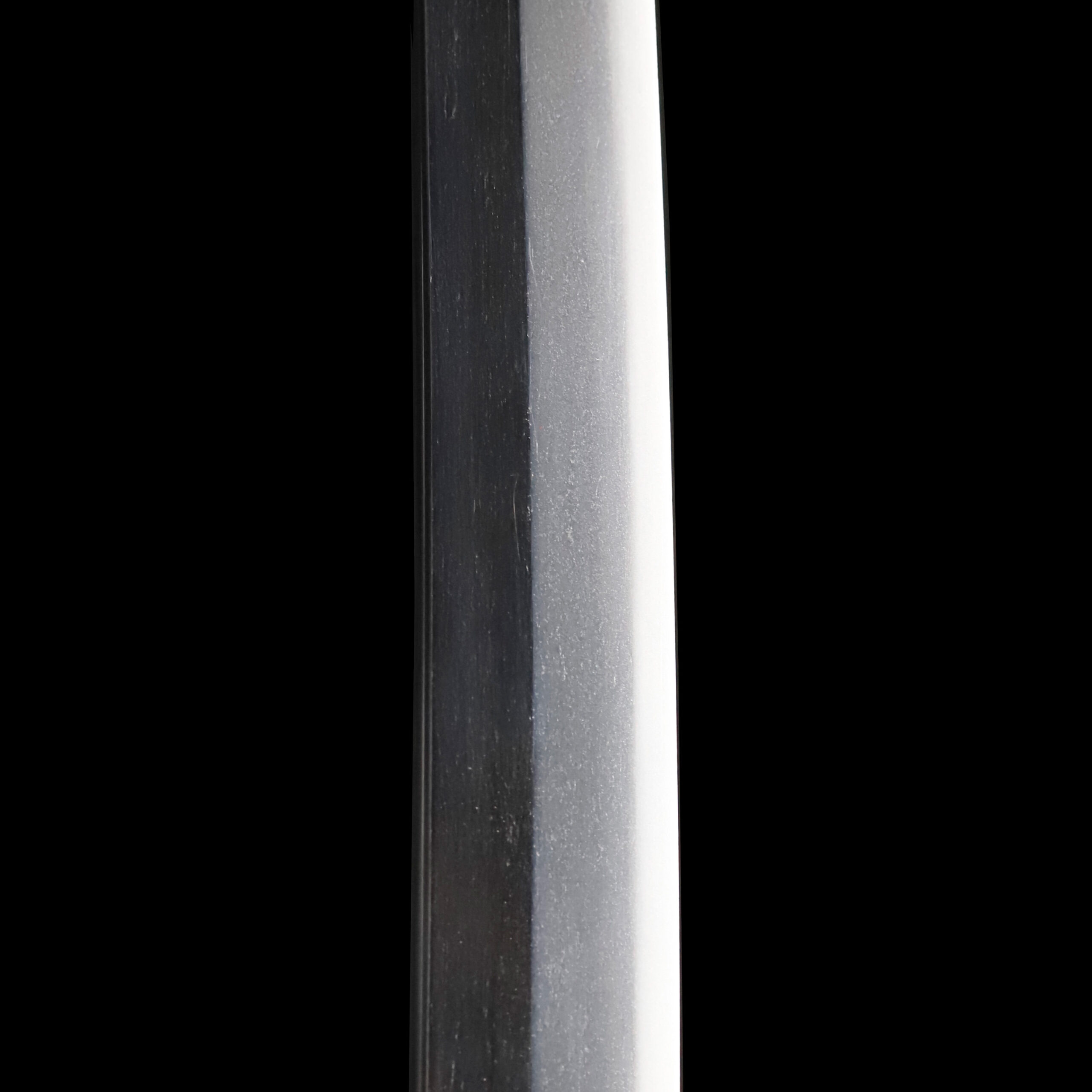
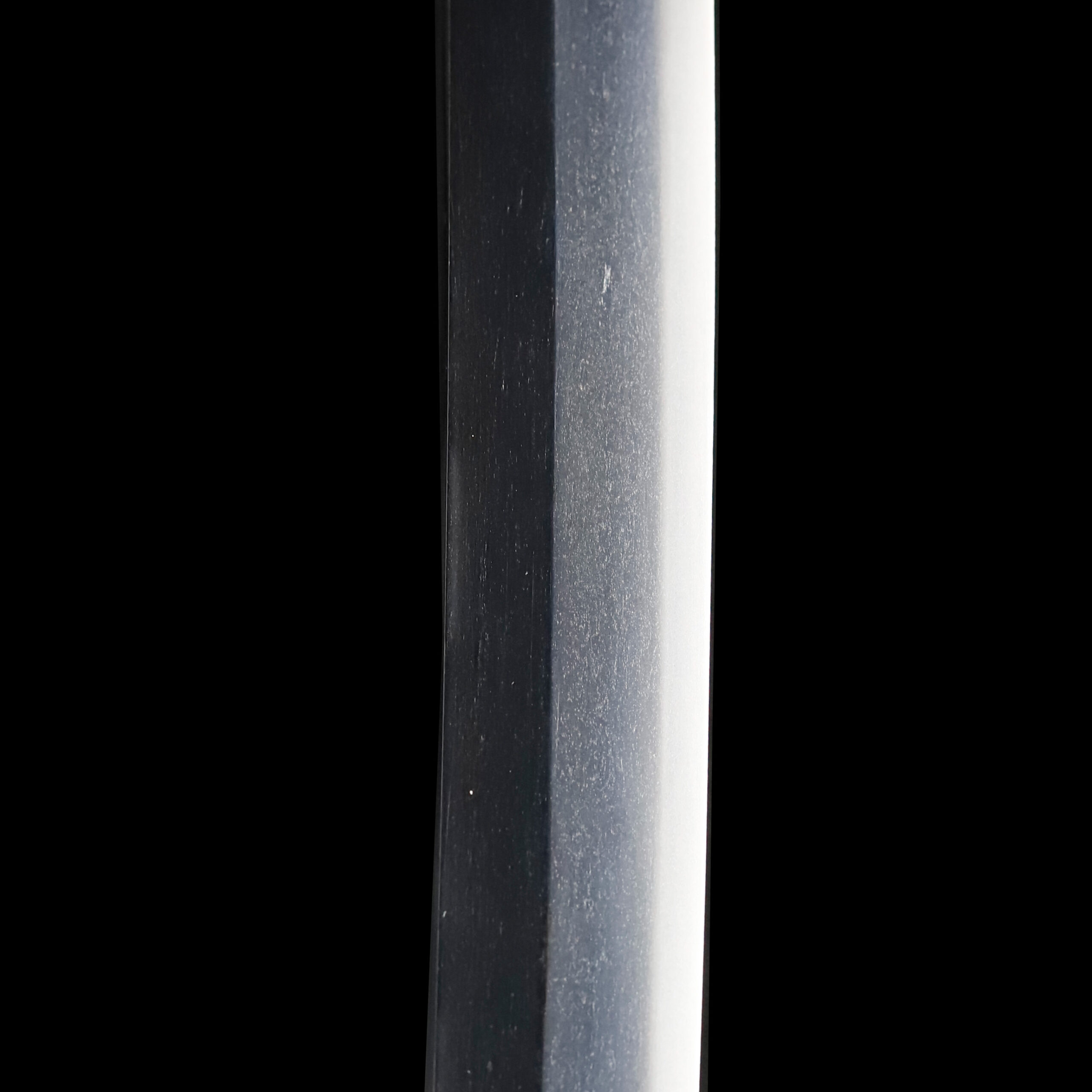
Nakago: Nakago is the tang of the Japanese sword.
Japanese swordsmiths left the black rust on the tang because it prevents red rust while the tang is in its handle. And the discoloration of the tang was created over time, and it is a great indicator for a Japanese sword specialist to estimate when the sword was forged.
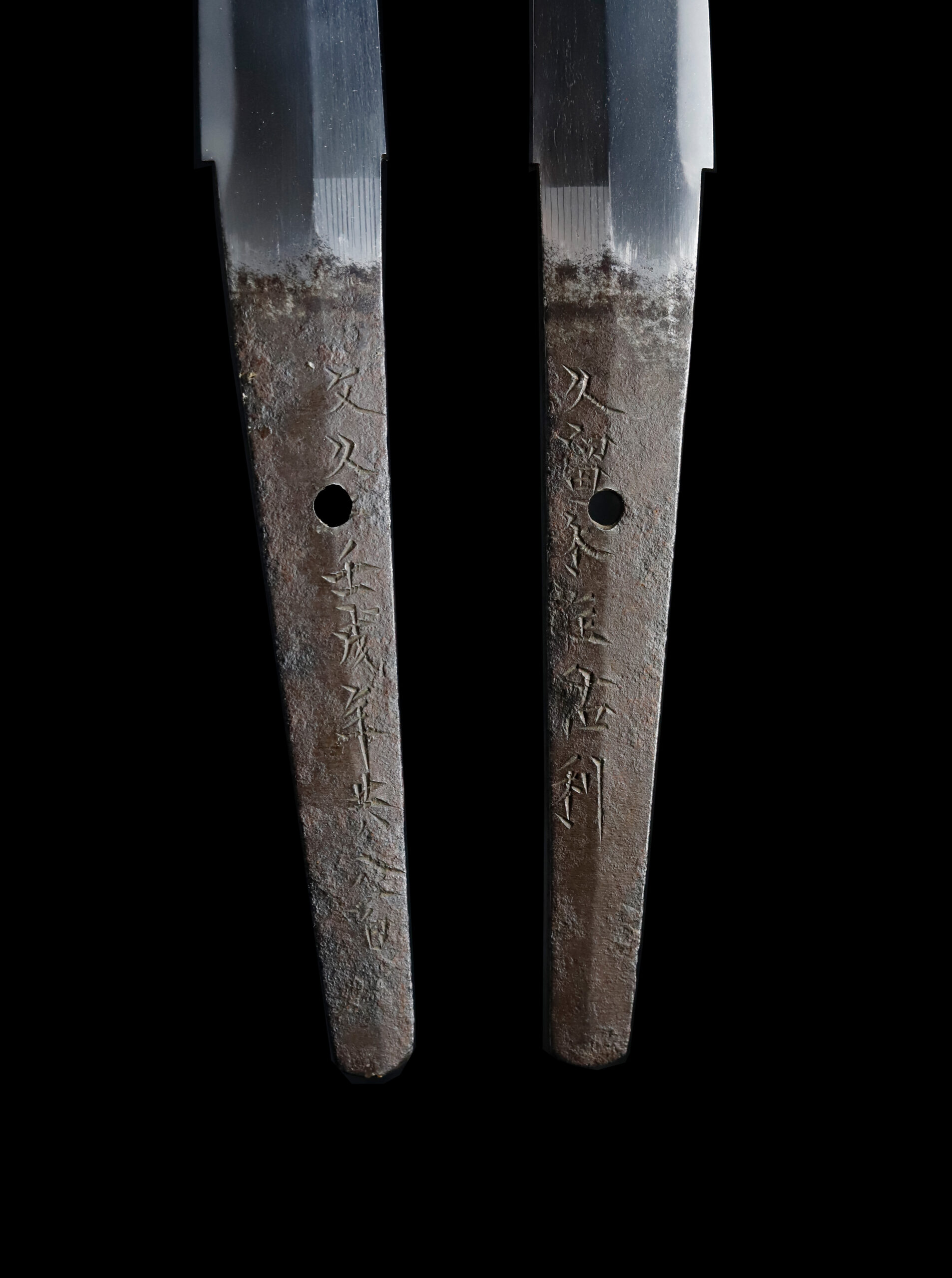
Koshirae: Koshirae is the mounting of the Japanese sword. There are several parts that consist of Koshirae such as Saya (Scabbard), Tsuka (Handle), Tsuba (Handguard).
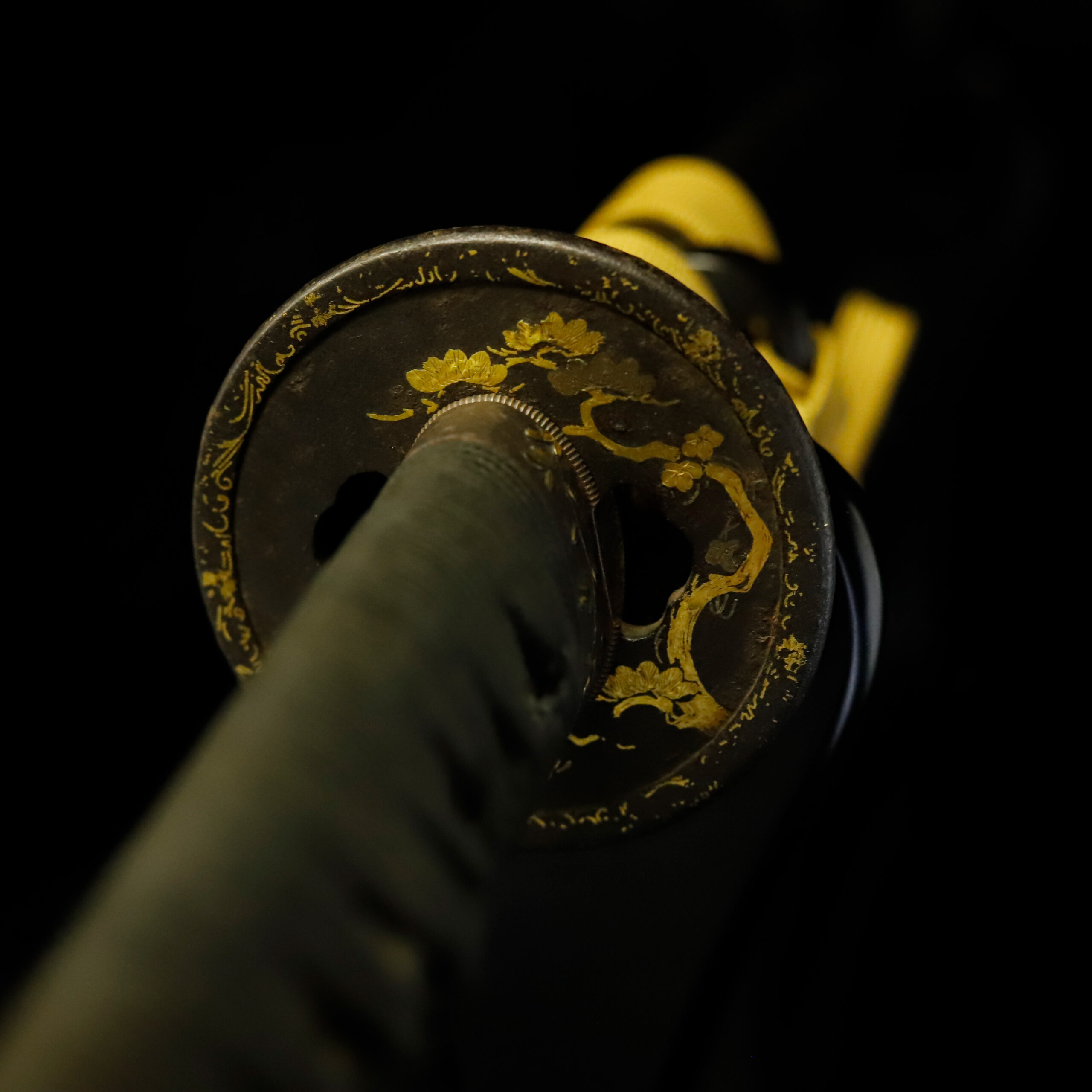
Fuchi-Kashira: A pair of matching sword fittings that cover the upper and bottom parts of its sword hilt.
This Fuchi Kashira has different designs on each part. A plant pattern is engraved on the Fuchi, and curving vine-like things are designed on the Kashira part. We estimate these objects depicted with curves are simplified versions of dragons. Among dragons, there is the Ameryu (雨龍). The Ameryu, also called Amaryou, is a kind of dragon who controls the rain. It is believed that Ameryus would make rain in the proof when God is blessed. According to a theory, an Ameryu is the young shape of a dragon. That is why they are sometimes depicted with a charming look compared to other types of dragons. This creature has been thought to be a small spirit who lives in forests. As mentioned above, their appearance has a similarity to a dragon. Moreover, snake worship was common in Japan because the serpent has a deep relationship with the water god faith. It might be the reason why Japanese people love the Ameryu pattern.
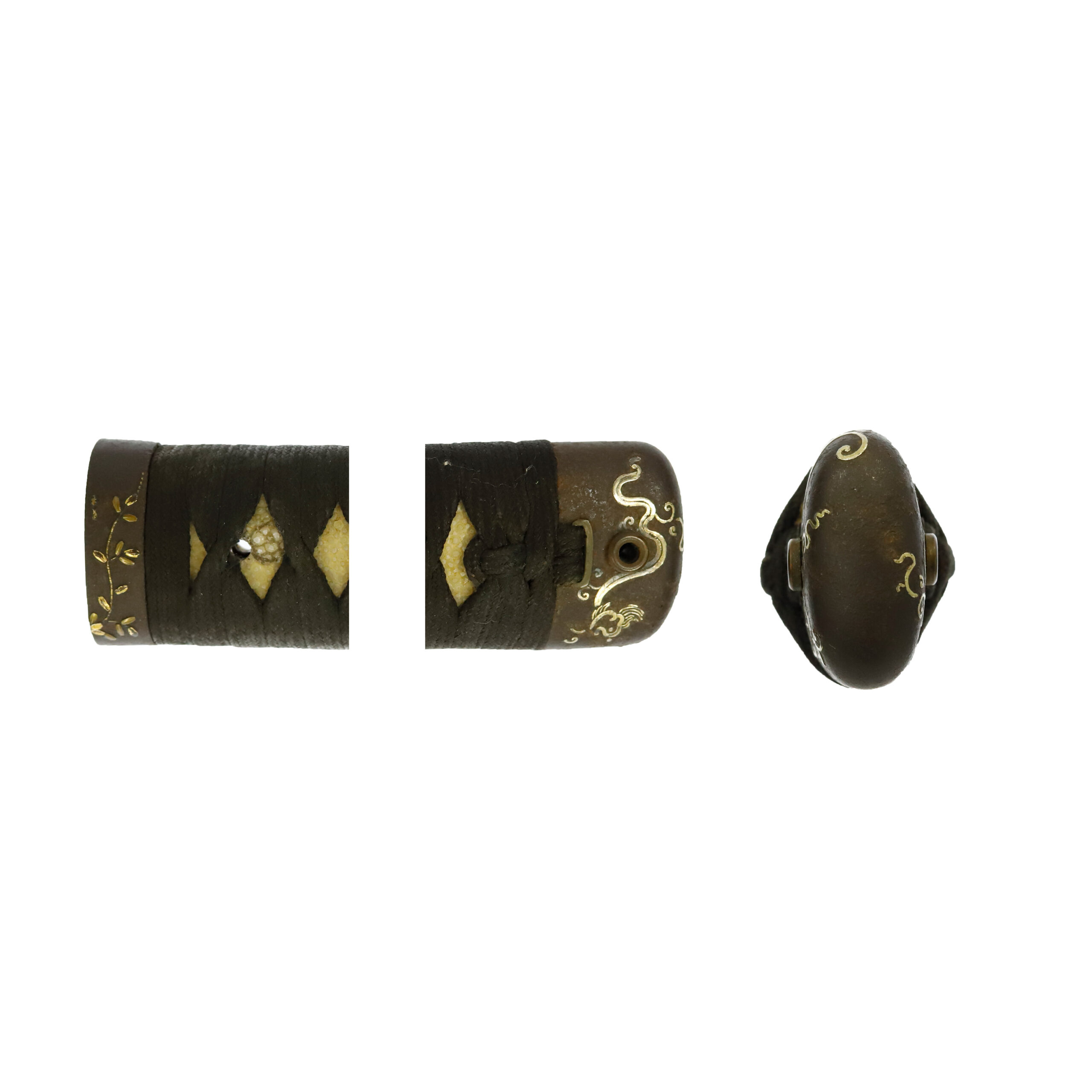
Tsuka and Menuki: Tsuka is the handle of the Japanese sword and Menuki is its decoration.
We could find the figure of a bird through the gaps of the Tsukamaki thread. We assume these are cranes. There is a proverb that believes that cranes and turtles live long lives. It says cranes have a lifespan of up to one thousand years, and turtles live around ten thousand years. Therefore, cranes and turtles have been considered symbols of longevity for a long time. Also, since cranes make compatible couples, their pattern represents a happy marriage. Due to their pure white feathers and dignified appearance, it was favorably used as a good omen design for various ornaments or furnishings such as the Kimonos (着物, traditional Japanese costume) or Obis (帯, belt for Kimono). Senbazuru (千羽鶴, thousand cranes) is one of Japan’s most popular Origami crafts, which is made of Origami paper. A thousand cranes of paper are joined, and it is mainly used for wishes of recovery. In this way, cranes have been familiar to Japanese people as auspicious motifs.

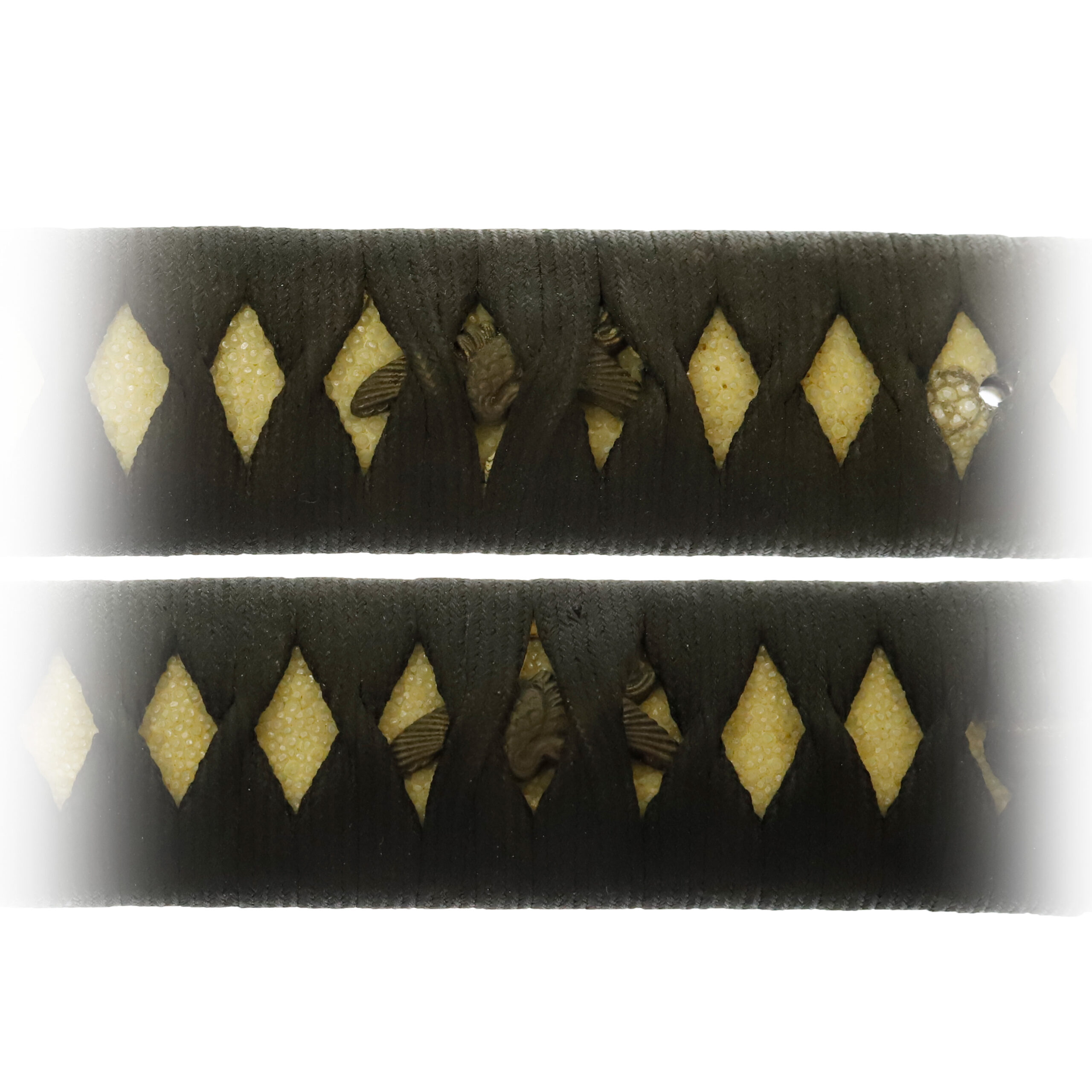
Tsuba and Habaki: Tsuba is the handguard for the Japanese Sword and Habaki is the equipment to make the blade not touch its scabbard inside. It prevents the blade from getting rusty and chipped.
The Mimi (耳, edge) of this Tsuba is thickly finished. While some colorings have already faded due to aging, it seems the golden vine pattern is inlaid on this Mimi part. The principal plant motif of this Tsuba’s design is the Matsu (松, pine tree). Since pine trees keep their green color throughout the years by withstanding severe heat and cold, people thought this plant pattern represents eternal youth. Furthermore, its color is called the Tokiwa-Iro (常盤色, evergreen trees’ dark green color with brown), and pine trees have another name: Tokiwa-Gi (常盤木). Tokiwa means immutability, so Tokiwa-Iro is a color that praises green with a wish for longevity and prosperity. It is said this color was appreciated, especially in the Edo period, as a good-luck color. The pine tree design gives us an elegant and noble impression; it might be another reason that people appreciate this motif.
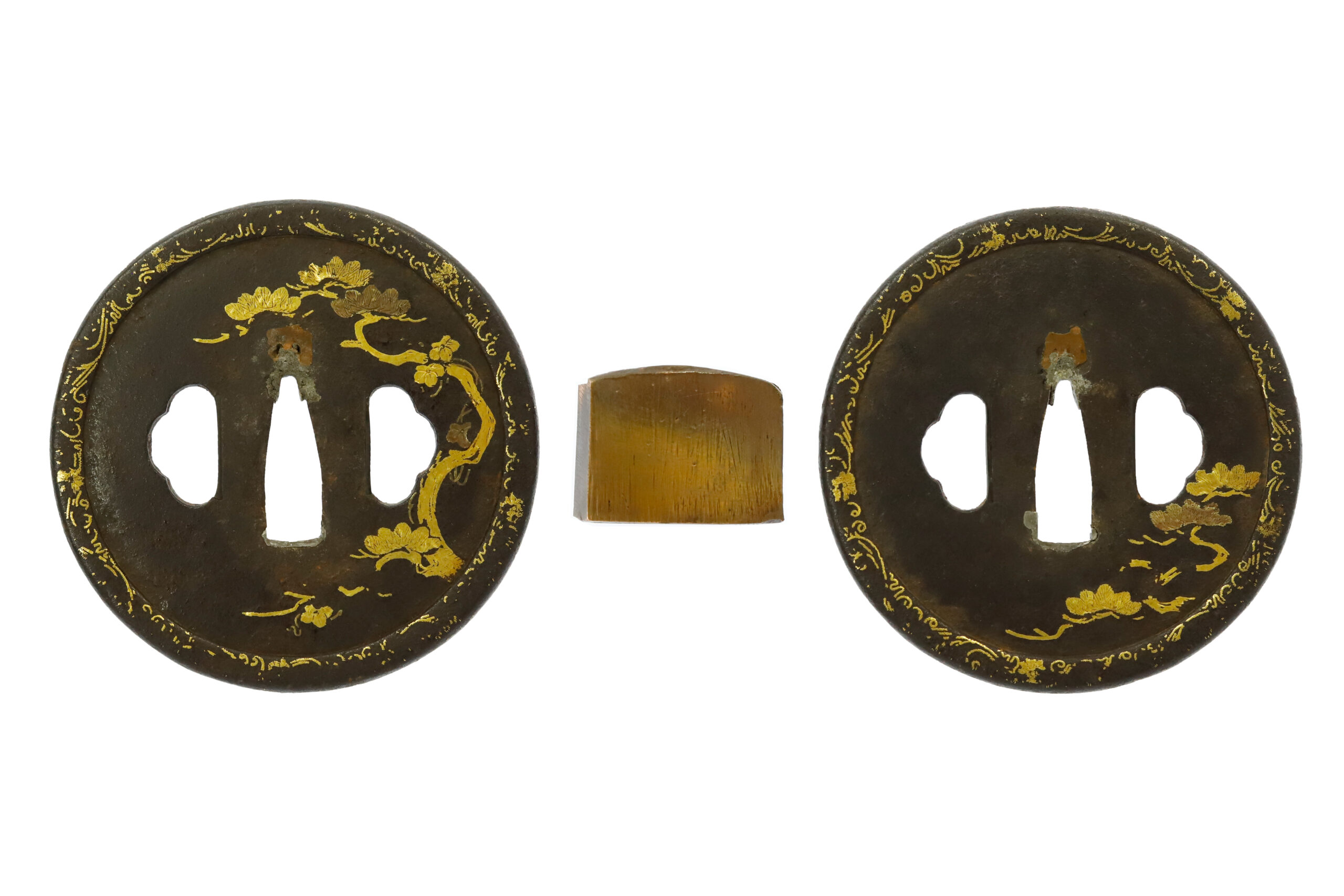
Saya: Saya is the scabbard for the Japanese sword.
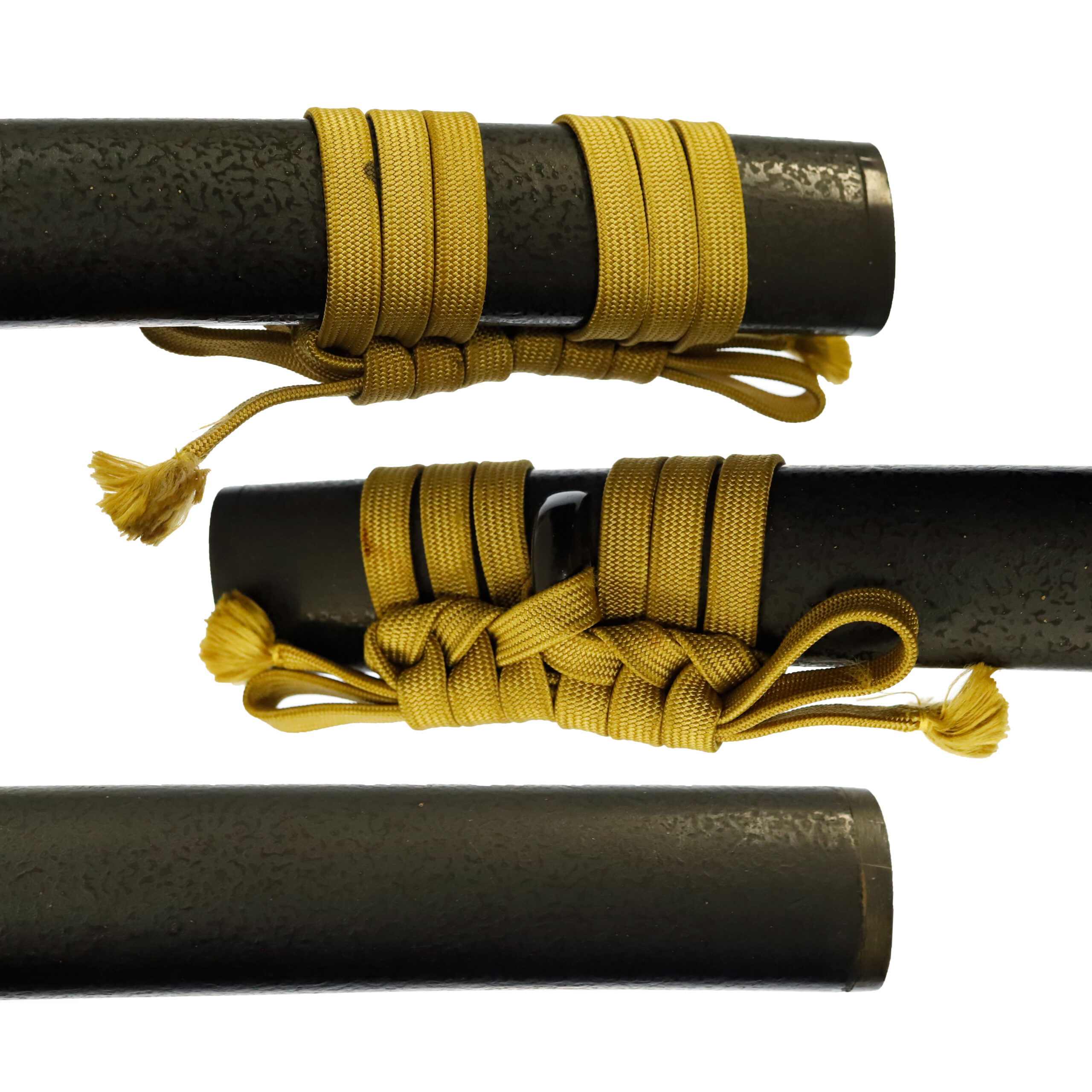
Authentication Paper: NBTHK Hozon Certificate for the blade (No. 3023748)
NBTHK, also known as Nihon Bijutsu Touken Hozon Kyokai (the Society for the Preservation of the Japan Art Sword), is one of the oldest Japanese sword appraising organizations in modern-day Japan. They authenticated the blade on June 25th in the 2nd year of Reiwa (2020). They appraised it as Hozon Touken, the blade especially worth preserving for Japanese society. The purchaser will receive this original certificate as well. We can also translate what is written into English and make a PDF file for your record if you request.
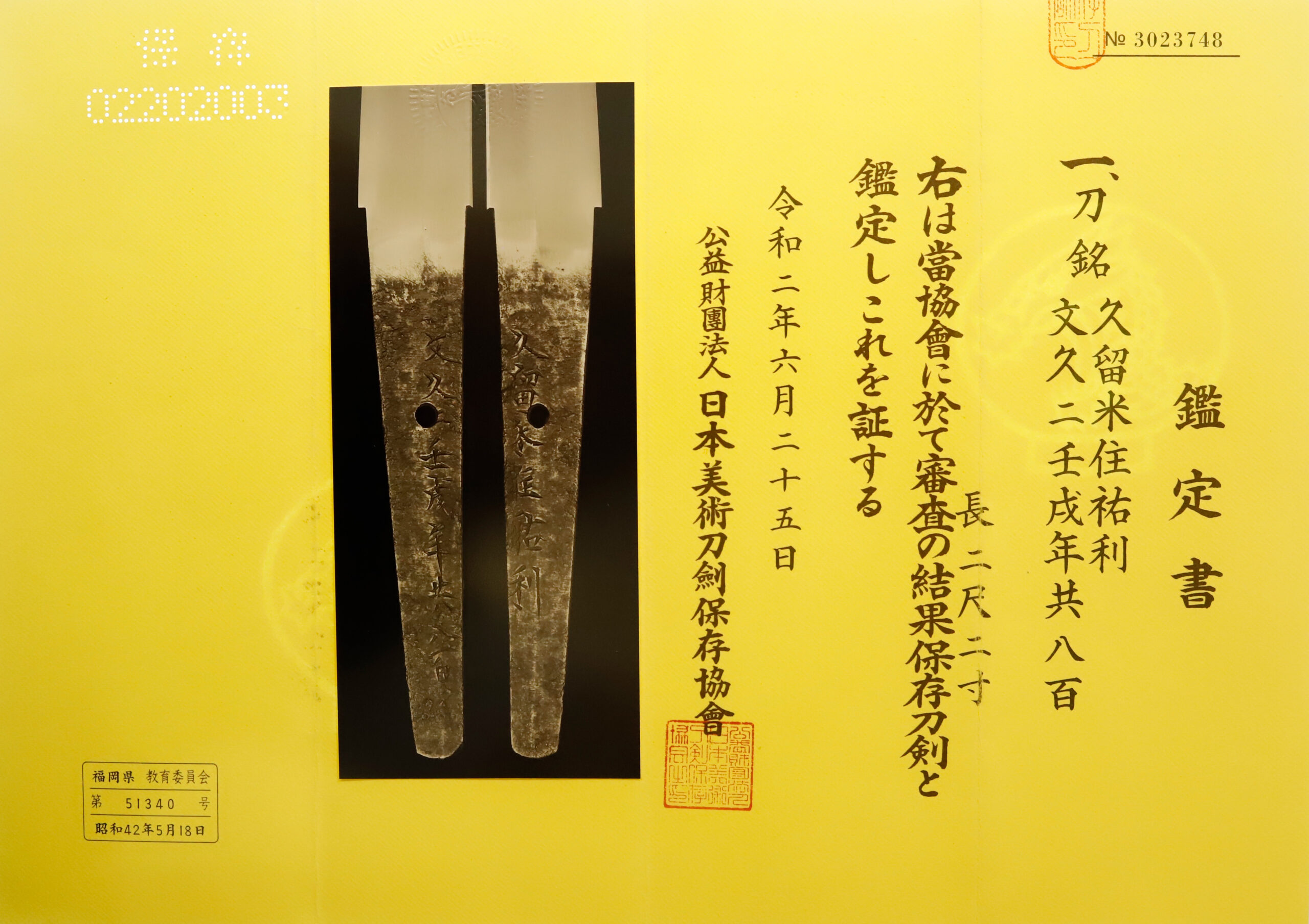
Registration Number: Fukuoka 51340
The Board of Education in Fukuoka prefecture issued a registration paper for this sword . It is called Jyu Hou Touken Rui Tourokusho (銃砲刀剣類登録証). Bunkacho (The Agency for Cultural Affairs) acknowledges a Japanese sword with this paper as a work of art.
The sword needs to be traditionally hand-forged and made of Tamahagane carbon steel to be registered in the system. With this paper, its owner in Japan can legally own an authentic Japanese sword. Based on this registration number, we will apply for its export permit.
This paper will need to be returned to the board of education when the sword is being shipped abroad, but you can receive a copy of it. An English translation of this registration paper is available on request.
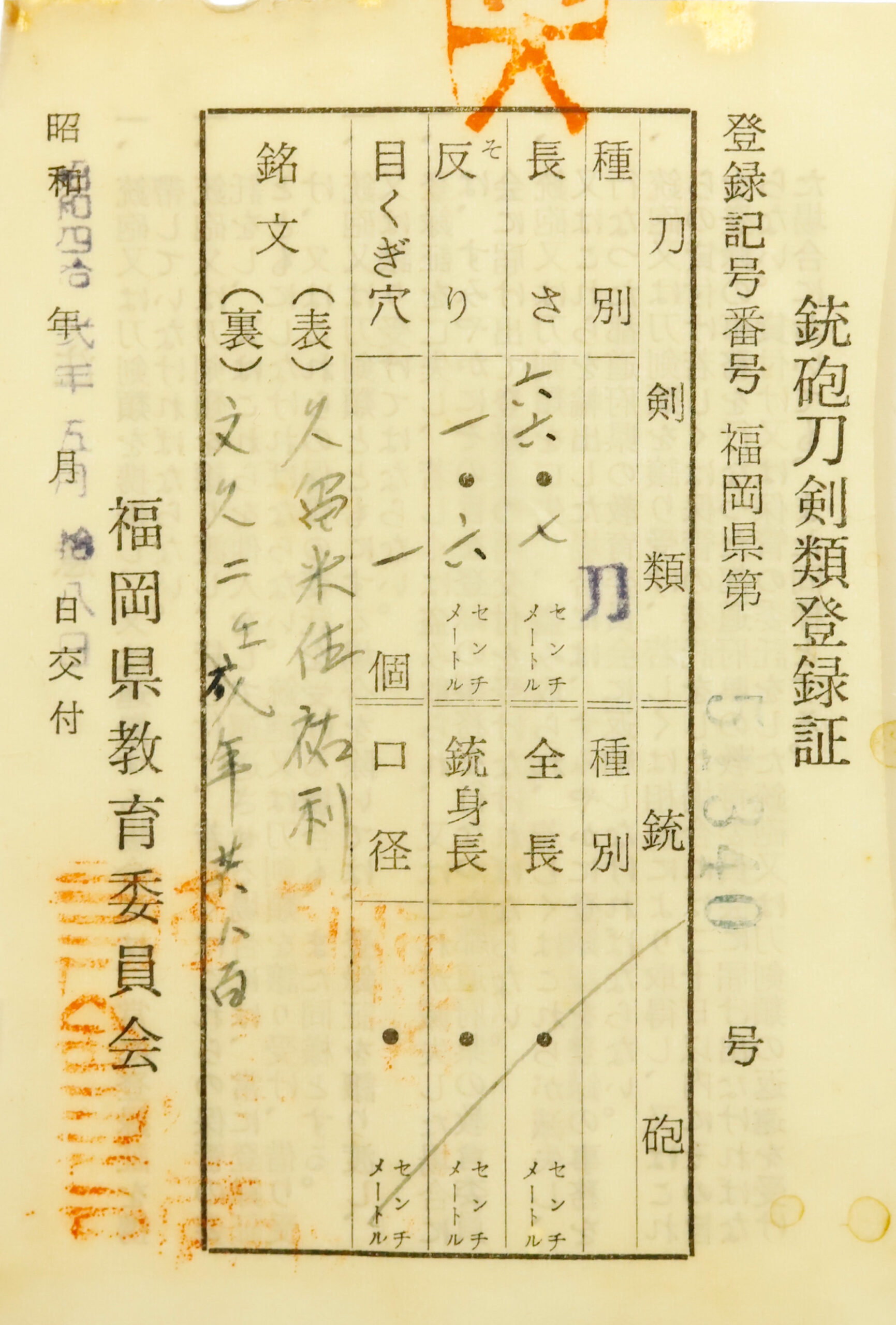

【About us】
Samurai Museum is located in Tokyo, Japan, exhibiting antique artifacts related to the Samurai history. Samurai Museum Shop is the place for those who are interested in Japanese culture and craftsmanship. We deal with antique Samurai swords/armor, traditional crafts made in Japan and so on.
【Japanese Sword& Export Process】
The Japanese swords we deal with are hand-forged edged swords made in Japan. It was made from the traditional carbon steel called TAMAHAGANE(玉鋼). Samurai Museum is familiar with the proper legal procedure for an antique/ authentic Japanese sword to be exported from Japan. We have sent more than 700 Japanese swords for the past few years (~2024) to amazing owners who appreciate its historical value.
Each Japanese sword is registered under the Agency for Cultural Affairs and the Board of Education in Japan. They issue a registration paper for each Japanese sword for its owner in Japan to legally possess it. The Japanese sword with its registration paper means it was traditionally hand-forged in Japan.
To legally export the sword from Japan to other countries, we will have to apply for its permit to the Agency for Cultural Affairs(Bunkacho) and return the original registration paper to the Board of Education. It normally takes around 2-4 weeks to receive this permit after submitting required documents. And we would like you to expect at least 1-1.5 months for your order to arrive at your given address after you ordered. For more detailed info, please click here.
It is allowed for residents in Japan to own authentic Japanese swords without a special license as long as they come with registration papers. Please feel free to contact us if you are a resident of Japan, whether temporarily or permanently. We will also assist you when you leave Japan and need to obtain the export permit.
【Payment Method】
We accept payment through Stripe (Credit card), PayPal, Apple Pay or ChromePay, all of which are secure payment methods. Also, you don’t need to make an account on Stripe for the checkout. If you prefer other payment method, please contact us. After confirming your payment, we will apply for an export permit. You may either pay in JPY, USD, AUD, CAD,EUR CHF or GBP. The price is set in Japanese Yen. Prices in other currencies are automatically calculated based on the latest exchange rate.

* If the amount is above 1 million JPY, Stripe or wire transfer will be the only options for payment.
【Shipping】
We have shipped authentic Japanese swords to the USA, UK, Canada, Mexico, Germany, France, Hong Kong, Finland and Australia. If you don’t live in these countries and like to order, please contact us first before making a purchase. We offer Free International Shipping as long as we can send antique Japanese swords by EMS.
We normally ship by EMS(Express Mail Service) provided by Japan Post. We will send you a tracking number for your order as soon as we hand it to the post office. We will put 100 % insurance on the shipping document without any extra charge. Based on the total amount, there might be a duty tax or other fee for you to pay, depending on the countries. We use package cushioning to protect the item and put it in a PVC pipe, which is one of the most secure packages because of its durability.
It will normally takes 5-14 days for the item to arrive at your given address after we dispatch it. Time of delivery is estimated as accurately as possible by the carrier but does not take into account any delays beyond our control such as by inclement weather, post office holiday seasons.
* If you live in Australia and like to purchase an authentic Japanese sword, please click here to know the detail.

【Review】
Here is one of the reviews we received from a customer who purchased an authentic Japanese sword from us. For more reviews, please click here.
“My experience overall with the whole process was wonderful. I had many questions about the history and process to purchase these treasures. All my questions were answered very timely and complete. The staff is very knowledgeable and very well versed if any questions do arise.”
【How to make sure the condition】
Please keep in mind that what you are going to purchase is an antique item. We uploaded high resolution photos for you to check its condition thoroughly. If you like to see more photos with different angles, please feel free to contact us. We will be happy to send them to you so that you can make informed decision. It is essential for us to know that you are happy with your choice of a sword. and we are prepared to use the best of our ability to serve you.
【How To Contact Us】
Please contact us through email, Facebook Messenger or Live Chat if you have any questions. You can find each icon on the right side of the website. Please click one of them to reach us. We will reply to you within 1-2 business days.
【The Art of Nihonto (Japanese Sword)】
Samurai’s history is a profound, eloquent legacy of ancient Japanese warriors in which millions of people worldwide are being fascinated. If you like to find out the art of Nihonto, please click here.
【A Guide to Japanese Sword Maintenance】
After acquiring an genuine Japanese sword, it is also important to know how to take good care of it. Here is the special video for you. Mr. Paul Martin, Japanese sword expert, shows you how to give proper maintenance to your sword. By mastering how to clean the Japanese sword, its aesthetic beauty will last forever.
When you purchase a Japanese sword from us, you can get a Free Japanese sword maintenance kit. It comes with four tools(Choji Oil, Uchiko Whetstone Powder, Peg remover, Oil Applicator). By watching the video instruction above , you can enjoy learning how to maintain your Japanese sword while appreciating it. If you have any difficulty assembling the sword or cleaning the blade, you can feel free to contact us.


MORE ANTIQUE JAPANESE SWORD FOR SALE
SWORDS WITHOUT CERTIFICATES FOR SALE
LEARN JAPANESE SWORD TERMINOLOGY
Thank you for reading all the information on the page. If you have any difficulty choosing the right Japanese sword for you, we will be more than happy to help you find the one that speaks to you the most. Please feel free to contact us.
